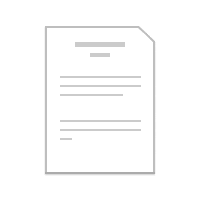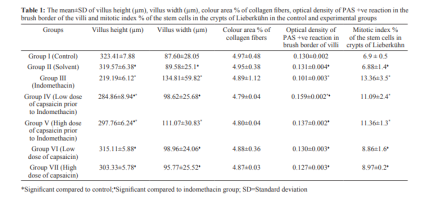Capsaicin is the active ingredient in peppers
cayenne has 1.25 - 2.5mg capsaicin per gram dry weight.
~10mg human equivalent in mice prevents gut barrier dysfunction through mucin secretion
Mucin secretory action of capsaicin prevents high fat diet-induced gut barrier dysfunction in C57BL/6 mice colon - PubMed
?does low dose <10mg stimulate a healthy response without damaging intestinal cells?
It has a short half life. but 2g of (i think) dry cayenne pepper powder in juice, works better than 4g for protecting gut cells (~2.5mg vs 5mg capsaicin)

Capsaicin induces a protective effect on gastric mucosa along with decreased expression of inflammatory molecules in a gastritis model (cox-2 inhibition maybe not good for wound healing? as pge2 needed? but maybe not a problem so short lasting. other mechanisms outweigh this?)
*& does it have painkilling effects which might mask damage? do not want 100s or maybe 10s of milligrams with gut problems
Different mechanisms were suggested for the protective effect of small doses (100-800 µg/kg)
[~ 1mg to 8mg human dose with 1mg working best] of capsaicin
https://jmh.journals.ekb.eg/article_179228_37d5f019990485beb97efcb070ecabbe.pdf
Ingestion of low dose of capsaicin prior to indomethacin prevented the effect of indomethacin on jejunal mucosa more than high dose
Useful study they included capsaicin only groups,
the high dose (~10mg human dose started negatively affecting villus height in the intestines (mildly), & showed inflammation + bleeding), and didnt protect as much as the low dose, so this amount is into damaging dose territory.
the low dose (~1mg human dose showed very mild drop in villus height with the increased width. and didnt show any signs of damage)


in chickens 2mg/kg increased villus height
1mg dose of capsaicin caused 0 bleeding or inflammation & protected intestine against damage (taken same time as damaging thing)
so assuming works the same in humans & if you include the extra dihydro form of capsaicin , then ~500mg of dried cayenne pepper powder or equivalent would be healthy intake
(protective effect against compounds might not be that useful its half life is short orally. but has an overall effect by the gut barrier study, tho would the lower dose also increase mucin the same without damage inducing mucin secretion? anyway this looks like the dose gut can tolerate at once without damage. in rats at least who also arent specialized for eating spicy stuff)
cayenne has 1.25 - 2.5mg capsaicin per gram dry weight.
---- so in total ~2mg compounds per gram of dry weight cayenne powderIn another study, cayenne pepper samples had mean capsaicin and dihydrocapsaicin contents of 1.32 and 0.83 mg/g dry weight, respectively <
~10mg human equivalent in mice prevents gut barrier dysfunction through mucin secretion
Mucin secretory action of capsaicin prevents high fat diet-induced gut barrier dysfunction in C57BL/6 mice colon - PubMed
?does low dose <10mg stimulate a healthy response without damaging intestinal cells?
It has a short half life. but 2g of (i think) dry cayenne pepper powder in juice, works better than 4g for protecting gut cells (~2.5mg vs 5mg capsaicin)
Evaluation of Anti-Ulcer activity of Capsicum annuum fruit extract by using Pylorus Ligation Model
Many herbalists believe that Capsicum annuum (cayenne) is the most useful and valuable herb in the herb kingdom, not only for the entire digestive system, but also for the heart and circulatory system. Because it acts as a catalyst and it increases
www.academia.edu
Capsaicin induces a protective effect on gastric mucosa along with decreased expression of inflammatory molecules in a gastritis model (cox-2 inhibition maybe not good for wound healing? as pge2 needed? but maybe not a problem so short lasting. other mechanisms outweigh this?)
*& does it have painkilling effects which might mask damage? do not want 100s or maybe 10s of milligrams with gut problems
Different mechanisms were suggested for the protective effect of small doses (100-800 µg/kg)
[~ 1mg to 8mg human dose with 1mg working best] of capsaicin
https://jmh.journals.ekb.eg/article_179228_37d5f019990485beb97efcb070ecabbe.pdf
Ingestion of low dose of capsaicin prior to indomethacin prevented the effect of indomethacin on jejunal mucosa more than high dose
Giving capsaicin in high doses (1mg/kg) in group V, half an hour prior to indomethacin produced a limited
protective effect against indomethacin compared to group IV. The percentage of inflammatory cell infiltration
in group V was significantly less within the connective tissue core of the villi, compared to indomethacin group
but more than that in group IV
Giving a low dose of capsaicin alone (100 µg/kg in group IV) half an hour prior to indomethacin eliminated
the harmful effect of indomethacin on the jejunal structure. So, capsaicin produced a significant protective effect
against indomethacin. The structure of the mucosa was nearly like control group. The percentage of haemorrhage
and inflammatory infiltration in the jejunum were significantly decreased comparing to group III
Useful study they included capsaicin only groups,
the high dose (~10mg human dose started negatively affecting villus height in the intestines (mildly), & showed inflammation + bleeding), and didnt protect as much as the low dose, so this amount is into damaging dose territory.
the low dose (~1mg human dose showed very mild drop in villus height with the increased width. and didnt show any signs of damage)
Effects of Capsaicin on Growth Performance, Meat Quality, Digestive Enzyme Activities, Intestinal Morphology, and Organ Indexes of BroilersCapsaicins protective effect was reported to be through various mechanisms such as increased gastric mucosal blood flow and gastric mucus secretion and facilitated gastric epithelial restitution [14].
Giving a higher dose of capsaicin only (1mg/kg in group VII) intragastrically produced some histopathological changes in the form of inflammatory cell infiltration andhaemorrhage. Also, in this group, there was PAS positive material in the brush border of enterocytes which was nearly like that of the control group. However, a few numbers of goblet cells evacuated their content. Capsaicinin this dose may act as an irritant to the mucosal lining and it stimulated the goblet cells to evacuate its content to produce a protective mucous layer.
The explanation of mucosal damage produced by large dose of capsaicinis through increase in cytosolic Ca++ that lead to mitochondrial damage and neuronal death. This causes mucosal desensitization which increases intestinal motility and decreases mucosal blood flow causing ischemia, interstitial haemorrhage, and inflammatory cellular infiltration.
capsaicin when given prior to indomethacin in a low dose (100 µg/kg BW) is more protective to jejunal mucosa against injury by indomethacin than the high dose(1 mg/kg BW)
in chickens 2mg/kg increased villus height
1mg dose of capsaicin caused 0 bleeding or inflammation & protected intestine against damage (taken same time as damaging thing)
so assuming works the same in humans & if you include the extra dihydro form of capsaicin , then ~500mg of dried cayenne pepper powder or equivalent would be healthy intake
(protective effect against compounds might not be that useful its half life is short orally. but has an overall effect by the gut barrier study, tho would the lower dose also increase mucin the same without damage inducing mucin secretion? anyway this looks like the dose gut can tolerate at once without damage. in rats at least who also arent specialized for eating spicy stuff)
Attachments
Last edited:

